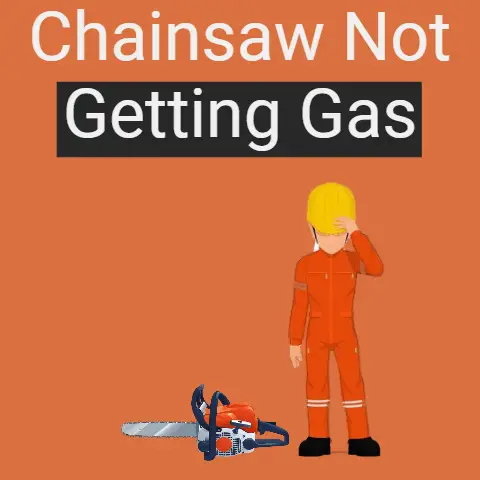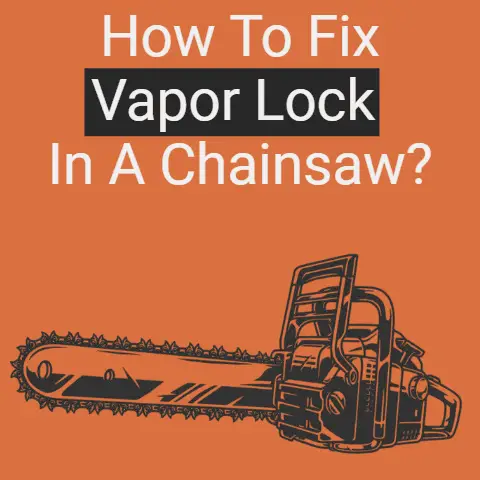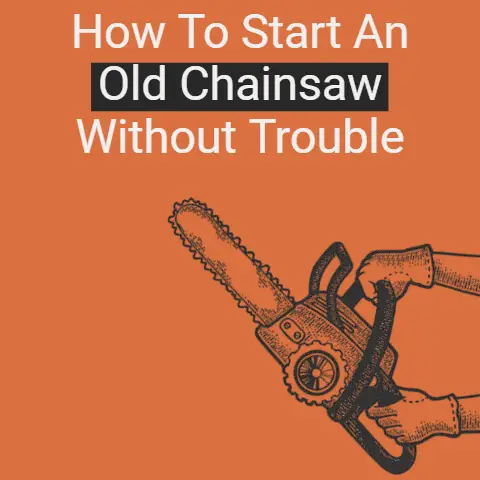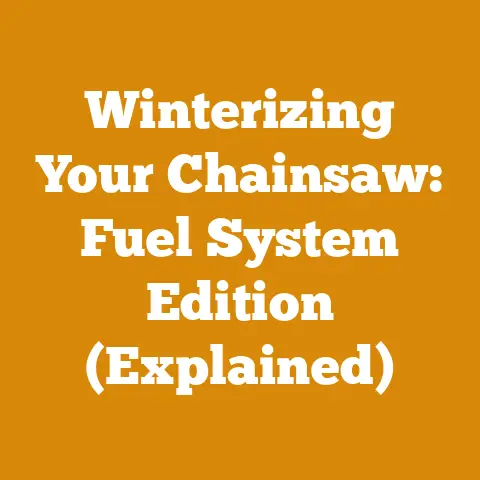Chainsaw Too Much Compression (15 Solutions Explained)
Carbon build-up in cylinder & piston, bad needle bearing, overused starter spring, oil in the starter system, old or bad fuel, etc can cause too much compression in Chainsaws. By checking & repairing/replacing these, you can fix the issue.
The Author
Too much compression can make it difficult to start or pull the starter cord.
High compression in chainsaws is a dangerous problem that can lead to serious injuries.
Chainsaws are very powerful tools, and if they’re not properly maintained, they can easily overcompress the chain, which can cause it to break.
This can lead to serious injuries, including cuts and amputations.
So be sure to keep your chainsaw properly maintained and avoid compression problems.
We will explain the causes of high compression and how you can quickly fix it to make it run smoothly.
So, If you feel too much compression while pulling a chainsaw, the possible reasons might be as below.
The Causes & solutions
#1
check the cylinder & piston for carbon build-up
If your chainsaw’s cylinder and piston have a lot of carbon build-up, it can cause the chainsaw to have high compression.
You’ll need to clean the cylinder and piston to fix this thoroughly.
First, remove the cylinder and piston from the chainsaw.
Then, use a wire brush to remove all the carbon build-up from the cylinder and piston.
Once you’ve done that, reassemble the chainsaw, which should work properly again.
#2
worn piston rings
Yes, it is true that chainsaw piston rings are responsible for sealing the combustion chamber, and if they are worn, they can allow too much compression to escape.
The piston rings create a tight seal between the piston and the cylinder wall, allowing the engine to build and maintain compression during the combustion process.
If the piston rings are worn or damaged, they may not be able to create a proper seal, resulting in low compression and poor engine performance.
In such cases, replacing the piston rings can help restore the proper compression and improve the chainsaw’s operation.
When replacing piston rings, it is important to use the correct size and ensure they are properly installed.
A piston ring compression kit, such as the Rotary 14626 Chainsaw Piston Ring Compression Kit, can be useful for assembling pistons and cylinders.
Additionally, a ring compressor and piston stop tool can help make the piston and cylinder installation easier.
#3
Cylinder base gasket
A removed or too thin cylinder base gasket can also contribute to high compression.
Checking and replacing the gasket if necessary may help resolve the issue
#4
scored or damaged cylinder
When the cylinder wall is scored or damaged, it can create irregularities that prevent the piston rings from creating a proper seal, leading to compression loss and poor engine performance.
In some cases, running a chainsaw with a scored piston can also lead to further damage to the cylinder.
The scoring can cause the piston to “wriggle” under load, damaging the top edge of the cylinder.
This can result in increased compression and further deterioration of the engine’s performance.
If you suspect that your chainsaw has a scored or damaged cylinder, it is recommended to disassemble the engine and inspect the cylinder and piston for any signs of scoring or damage.
Depending on the severity of the scoring, the cylinder and piston may need to be replaced.
Additionally, addressing the root cause of the scoring, such as using proper fuel and maintaining a clean air filter, can help prevent future damage to the engine.
#5
Wrong carburetor
Have you recently replaced the carb?
Using the wrong carburetor can cause the engine to run too lean, leading to increased compression.
Ensure that the correct carburetor is installed for your chainsaw model
#6
bad needle bearing
Remove the right side cover, bar, and chain. Turn the brake off.
If you find the brake drum moving, you must replace the needle bearing.
#7
Overuse Starter Spring
As the starter, spring plays a vital role in running starter assembly smoothly.
If the starter spring is keep working correctly, it will retract the ignition rope.
Sometimes the spring stops working correctly due to overuse and becomes brittle.
If you regularly use the chainsaw, then there might be the possibility that your starter spring breaks off.
So, in our suggestion, one of the first things to check while feeling high compression is the starter spring.
It is effortless to check the starter spring; pull the ignition rope.
If it is hard to pull, then check how the spring is performing.
If you see any unusual movement of spring, then take it in to replace it.
If you do not replace the starter spring on time, it will cause you to replace the whole starter assembly.
I hope you understand the problems why your chainsaw is hard to pull.
#8
Lack of Oil
Another big issue that causes too much high compression is the lack of oil in the starter system.
The lack of oil dries the chainsaw assembly, which causes high compression and becomes very difficult for you to handle the chainsaw.
The other reason might be the use of the wrong type of oil for the climate.
If you are trying to start your chainsaw in winter and the oil you used for the chainsaw assembly is not suitable for the winter season, you also feel high compression.
This is because your oil is not rated to get to work at a low temperature.
#9
Old contaminated fuel
Old gasoline can cause too much compression on a chainsaw.
Gasoline can go bad over time, especially if it contains ethanol, which can absorb moisture and cause corrosion in the fuel system.
When old gasoline is used in a chainsaw, it can cause the engine to run too lean, leading to increased compression and difficulty starting.
To prevent this issue, it is recommended to use fresh gasoline in your chainsaw and to avoid storing gasoline for extended periods of time.
If you need to store gasoline, use a fuel stabilizer to help prevent the gasoline from going bad.
Additionally, it is important to use the correct fuel-to-oil ratio for your chainsaw model and to maintain a clean air filter to ensure proper engine performance.
#10
Timing issues
If the timing is off, it can cause the chainsaw to have excessive compression.
Check the keyway alignment and tighten the nut to ensure proper timing
#11
clogged air filter
A clogged air filter can cause too much compression on a chainsaw.
When the air filter becomes clogged, the amount of air able to reach the combustion chamber drastically reduces, resulting in poor performance, sputtering, and failure to start.
This can lead to increased compression as the engine tries to compensate for the lack of air.
To fix this issue, you should check the air filter for buildup and replace it if necessary.
The air filter on a chainsaw removes airborne contaminants from entering the combustion chamber, so a clean and functioning air filter is essential for proper engine performance.
#12
The Starter Housing
Most of the time, the chainsaw cord became hard to pull because of the Starter Housing.
The Housing is the outer cover of the starter, and if it is damaged, your chainsaw suffers stiffness during a pull.
There might be a small stone or thing that is stuck inside the starter and causes the rope not to retract.
It is a prevalent issue and can be fixed and detected easily without consulting a mechanic.
You have an option to either pull off the starter and clean it or look for an ideal replacement for your starter house.
#13
Damaged Pulley compartment
The Pulley compartment plays a massive role in retracting the ignition rope.
While rope attached to a pulley, the further connection of the pulley is with springs and pawl to make sure the pulley is tensioned and helps in retracting and spinning.
If there is any damage to the pulley at any stage, it will cause “High Compression” or “stiffness during a pull.”
You can also quickly fix this anomaly by ensuring a proper troubleshooting of the pulley compartment to find damages.
Once you identify the cause of high compression, you can repair that affected part or find a new replacement for it to make it work smoothly.
#14
Stucked ignition rope
The other cause of your chainsaw’s high compression could be the stuck ignition rope.
The starter assembly often fails to rotate due to a weak connection between the pulley and the ignition rope.
Your ignition rope must be intact properly with the pulley to work correctly.
Sometimes, the ignition rope is frayed or stuck inside the starter housing.
Usually, this happens when you use a chainsaw after a very long time or by wear and tear of the rope.
Keep in mind that the stuck ignition rope can also damaged other parts inside the starter assembly.
So, replacing the ignition rope is a better option to keep everything working smoothly without any damage.
#15
Professional Inspection
If you’re unable to identify the problem or fix it on your own, it’s advisable to take the chainsaw to a professional technician who can diagnose and repair the issue.
What is Chainsaw Compression
An engine is fit on the rear side of a chainsaw.
The engine creates a vacuum pressure inside it.
This compression converts fuel (any source) into the potential energy in the engine to start it.
If the compression is not produced in the engine at an appropriate level, it will not be able to convert fuel into energy.
Every chainsaw requires a specific amount of compression if this compression is more or less than the required amount, the engine will not be able to produce energy from the fuel source, and it will be exhausted faster.
A compression gauge is used to measure the compression of a chainsaw which works similarly to the tire gauge.
Every chainsaw requires a different compression level according to its built-up and model number.
A heavy-duty chainsaw requires a large amount of compression, whereas a chainsaw with a smaller engine needs less compression to convert fuel into energy.
If a chainsaw has a 2 stroke engine, then the maximum compression it requires is 110-130 PSI.
Similarly, a 4-stroke engine needs 2 times more compression than a 2-stroke engine, around 180-210 PSI.
how much compression Does the chainsaw Engine need
Now, how much compression the engine of a chainsaw needs depends upon its motor capacity and temperature.
This could be understood by reading the further explanation below.
Capacity Of The Engine
The power of the motor of an engine is measured in its capacity.
Every chainsaw engine has a different capacity depending upon its motor power.
A large engine has a huge capacity in its motor.
Obviously, the motor, which has a huge capacity, will require more compression.
The chainsaw motor engine capacity can range from 30CC and 50CC to 150 CC.
A 50CC engine needs 150 PSI compression.
The compression limit should also be doubled if the engine capacity is 100 CC.
Temperature Of The Engine
A heavy-duty engine gets hot faster and works better than a cold engine.
A hot engine also requires more compression to convert furl into energy as compared to the colder one.
A cold engine will need the compression of 50-100 PSI whereas a hot engine will require compression above 150 PSI.
Too much hot or cold engine does not work or even start to produce vacuum pressure inside engine.
Therefore, it does not need any compression rate to start.
Without proper compression, the engine will not be able to suck and use the fuel for combustion.
Finally the fuel will be converted into energy.
A highly compressed engine will not be able to work smoothly because of the too much pressure on engine and you will find it hard to start the engine.
Likewise, low compression in the engine will be slow and retarding and it is a warning sign of leakage in your engine.
In this case fixing or repairing is required or worst replacing the engine all at once.
Final Thought
We describe all the possible issues and also suggest the solutions to fix them too.
If you still have questions regarding high chainsaw compression, you can discuss them in the comments.






